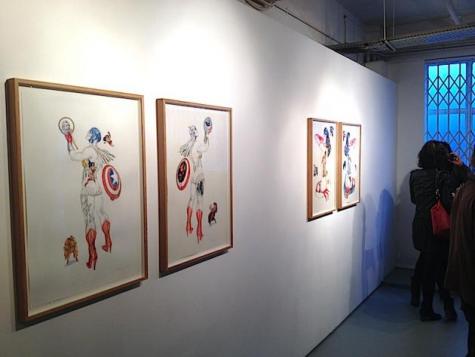A review of Margaret Harrison's latest exhibit in London. Originally published via the London-based art network artlyst.

The stout, lumpy figure of Ena Sharples stands at the corner of a functional looking balcony staring out over the rooftops of an anonymous urban landscape. A mishmash of red brick terraced streets fades into obscurity behind her. She slumps heavily over the railings wearing an unflattering Ulster coat and an expression of discontent. It's a melancholy portrait.
Ena Sharples was one of the original characters in Coronation Street, the ever popular British soap about the lives of a working class community in a fictional suburb of Manchester. Sharples was a cantankerous but moral character who never remarried after her husband's premature death during the Depression. These dingy streets were her world.
Photo: artlyst.com
Over this world Margaret Harrison has superimposed technicolor vignettes of performed 'femaleness'. In the top corner Wonder Woman flies into the scene wearing her trademark superhero outfit. It is little more than a strapless swimming costume from which her amble bosom threatens to burst at any moment. Although chronologically her contemporary, as a manifestation of the female form a further cry from the down-at-heel, utilitarian Sharples the viewer could hardly imagine. In the opposite corner a youthful Mick Jagger, long haired and dizzyingly handsome, holds a microphone to his face. He also is performing.
Elsewhere fetishistically high heeled footwear floats anchor-less. In the bottom corner a jarring monochrome image is immediately recognisable as a scene from the Battle of Orgreave. A policeman in riot gear leans from a horse and hurls a truncheon at the head of an isolated and vulnerable miner. What we are looking at is two men and a horse. What we see is that other extreme in the lexicon of archetypal female figures: Margaret Thatcher.
Right beside Sharples we see her double. Harrison has flipped the picture to give us two perspectives on the same shot. The original and it's reflection. The images are not an exact match. The screen prints don't line up properly for a start. Then Harrison has added aquatint in different places. On the left hand print Sharples' face is black and white. On the right hand print it has flesh tones. On the left hand image her coat is dark grey. On the right, light grey.
The same device is deployed elsewhere in the exhibition, this reflection that isn't quite. In Very Close to getting in touch with my Masculinity we see Captain America, rippling tree trunk thighs wrapped in sheer nylon and sporting Wonder Woman's knee high boots. He holds a vanity mirror high up to his face and puckers his lips. Instead of a chiselled jaw what is reflected back is, in one instance, Wonder Woman jutting her cross chin at him in a gesture of aggressive rebellion, and in the other a lady in Islamic dress gives an open mouthed wail of grief. Captain America seems gloriously unaware of this tragic conflict and continues to revel in his own reflected image. The central of his shield's concentric circles frames a snippet of the English Pre-Raphelite painter John William Waterhouse's 1903 painting Echo and Narcissus. The Waterhouse painting is currently in the collection of the Walker Art Gallery, Liverpool, another reference by Harrison to her own origination in the North of England. Mythologically Narcissus spurned women, instead falling in love with his own reflection. So enchanted was he with his own image he was unable to look away for long enough even to feed himself and so died a premature death. Elsewhere in Very Close to getting in touch with my Masculinity we find Josephine Baker in her infamous banana skirt. Baker was the first African American woman to star in a major motion picture. She was also an active member of the civil rights movement in the United States. Both of her parents were former slaves. These drawings are dense with reference.
Since the late 1960s Margaret Harrison has been at the forefront of feminist activism and feminist art practice. In 1970 she founded the London Women's Liberation Art Group. In 1971 she had an exhibition that effectively constituted the first overtly feminist solo show in London. It was probably also the shortest being closed by the police after one day on grounds of indecency. Interestingly, it seems what the authorities objected to was not so much the cheeky tits and arse irony of the female characters, but the transgendering of the male image.
by Beverley Knowles
Check out the full review on artlyst.

Commentaires
Permalien
Margaret Harrison
Margaret Harrison was the most recent recipient of the prestigious Northern Art Prize. She is also included in a new exhibition at the ICA London exploring Politics, Gender and Sexuality.
Ajouter un commentaire